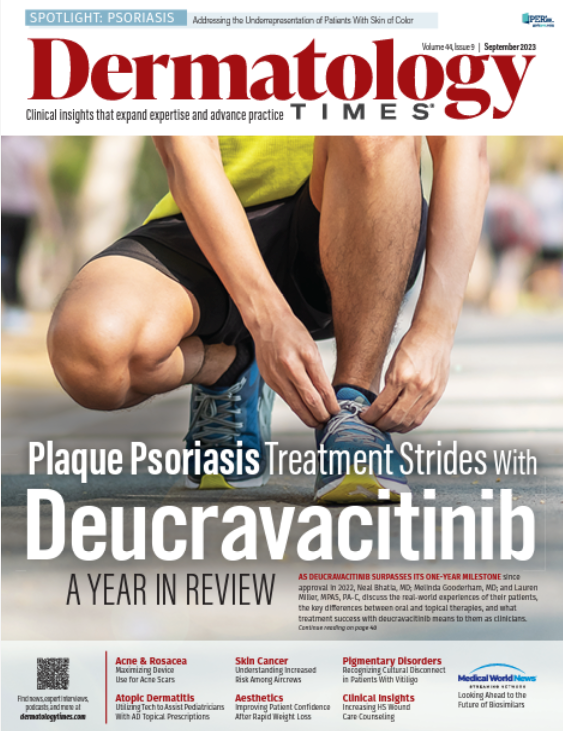- Case-Based Roundtable
- General Dermatology
- Eczema
- Chronic Hand Eczema
- Alopecia
- Aesthetics
- Vitiligo
- COVID-19
- Actinic Keratosis
- Precision Medicine and Biologics
- Rare Disease
- Wound Care
- Rosacea
- Psoriasis
- Psoriatic Arthritis
- Atopic Dermatitis
- Melasma
- NP and PA
- Skin Cancer
- Hidradenitis Suppurativa
- Drug Watch
- Pigmentary Disorders
- Acne
- Pediatric Dermatology
- Practice Management
- Prurigo Nodularis
- Buy-and-Bill
Feature
Article
Dermatology Times
Journal Digest: August 24
Author(s):
This week’s collection of the latest dermatologic studies covers PPT5α for androgenetic alopecia, fractional ablative CO2 laser and concurrent isotretinoin treatment for acne scars, vitamin D insufficiency and 25-hydroxy vitamin D levels related to cutaneous melanoma, and a literature review of baricitinib for alopecia areata.

Dermatologic Therapy: A Randomized, Double-Blind, Placebo-Controlled Clinical Trial to Assess the Efficacy of a Nutritional Supplement in Female Androgenic Alopecia
To evaluate the efficacy of the nutritional supplement Pilopeptan WOMAN 5αR (PPT5α) for the treatment of androgenetic alopecia (AGA), Arias et al completed a prospective, randomized, double-blind, placebo-controlled clinical trial that included 47 female patients, aged 25-29 years. Patients had AGA grade I/II and were randomized to receive daily PPT5α (n=24) or placebo (n=23). At 6 months, patients who received PPT5α showed high percentages of terminal hair both in the frontal (77.6% vs 69.8%) and parietal (77% vs 64.3%) areas compared to the placebo group. Self-assessed evaluation of hair parameters showed an improvement in the reduction of hair loss and hair thickness both at the 3-month 6-month visits. Arias et al concluded that their results suggest that PPT5α may help prevent the progression of AGA.
Lasers in Surgery and Medicine: Fractional Ablative CO2 Laser and Oral Isotretinoin—A Prospective Randomized Controlled Split-Face Trial Comparing Concurrent Versus Delayed Laser Treatment for Acne Scars
Taleb et al conducted a prospective, split-face, randomized control trial to evaluate the safety and efficacy of fractional ablative CO2 laser (FACL) in patients treated concurrently with isotretinoin vs patients treated with FACL 6 months post-isotretinoin treatment. Patients received 3 monthly sessions of FACL with concurrent isotretinoin treatment on half of their face, while the other side of the patient's face received the same FACL treatment regimen 6 months post-isotretinoin cessation. Three dermatologists used the Quantitative Global Acne Scarring Grading System (GASGS) to assess final cosmesis. GASGS scores of the concurrent isotretinoin-FACL treated side of the face was significantly lower than the side of the face treated with delayed laser therapy. Taleb et al concluded that “fractional ablative laser treatment is effective in improving acne scars, which persist despite isotretinoin therapy.”
Melanoma Research: Vitamin D Insufficiency and Serum Levels Related to the Incidence and Stage of Cutaneous Melanoma: A Systematic Review and Meta-Analysis
According to Shellenberger et al, vitamin D insufficiency has been previously suggested as a risk factor of cutaneous melanoma (CM), the deadliest skin cancer. In their study, the authors evaluated the relationship between both vitamin D insufficiency and 25-hydroxy vitamin D levels with the incidence and stage of CM. Shellenberger et al used 5 databases to search for cohort and case-control studies from inception to July 11, 2022, that reported mean 25-hydroxy vitamin D levels or the presence of vitamin D insufficiency in CM patients compared with healthy controls, or cases that reported vitamin D insufficiency and Breslow tumor depth or the development of metastasis in CM. From their results, the authors found an “association of increased incidence of CM and vitamin D insufficiency, as well as less favorable Breslow tumor depth with lower levels of vitamin D and the presence of vitamin D insufficiency.”
Journal of Drugs in Dermatology: Review of Baricitinib in the Treatment of Alopecia Areata
Singh et al completed a literature review using PubMed and EMBASE to search for articles published between January 2010 to November 2022 that discussed the efficacy and safety of baricitinib for alopecia areata. Pharmacodynamic and pharmacokinetic profiles were also included. The authors reviewed the 2 identical phase 3 trials, BRAVE-AA1 and BRAVE-AA2. A larger percentage of patients who received baricitinib 4 mg or 2 mg dose achieved a Severity of Alopecia Tool score ≤20 vs placebo. In BRAVE-AA1, for 4 mg, 2 mg, and placebo, respectively, these values were 38.8%, 22.8%, and 6.2%; in BRAVE-AA2, these values were 35.9%, 19.4%, and 3.3% (P<0.001). Despite the JAK inhibitor black-box warning, adverse events in both trials were mild or moderate. The authors conclude that additional studies are needed to evaluate baricitinib’s long-term efficacy and safety.
What new studies are most important to you? Share with us by emailing our team at DTEditor@mmhgroup.com.







